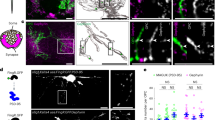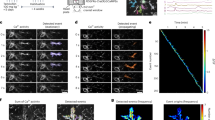Abstract
Oligodendrocyte precursor cells (OPCs), a major glial cell type that gives rise to myelinating oligodendrocytes in the CNS, express calcium-permeable AMPA receptors (CP-AMPARs). Although CP-AMPARs are important for OPC proliferation and neuron-glia signaling, they render OPCs susceptible to ischemic damage in early development. We identified factors controlling the dynamic regulation of AMPAR subtypes in OPCs from rat optic nerve and mouse cerebellar cortex. We found that activation of group 1 mGluRs drove an increase in the proportion of CP-AMPARs, reflected by an increase in single-channel conductance and inward rectification. This plasticity required the elevation of intracellular calcium and used PI3K, PICK-1 and the JNK pathway. In white matter, neurons and astrocytes release both ATP and glutamate. Unexpectedly, activation of purinergic receptors in OPCs decreased CP-AMPAR expression, suggesting a capacity for homeostatic regulation. Finally, we found that stargazin-related transmembrane AMPAR regulatory proteins, which are critical for AMPAR surface expression in neurons, regulate CP-AMPAR plasticity in OPCs.
This is a preview of subscription content, access via your institution
Access options
Subscribe to this journal
Receive 12 print issues and online access
$209.00 per year
only $17.42 per issue
Buy this article
- Purchase on Springer Link
- Instant access to full article PDF
Prices may be subject to local taxes which are calculated during checkout







Similar content being viewed by others
Change history
20 October 2011
In the HTML version of this article initially published online, the name of one of the corresponding authors was incorrect. The error has been corrected for the HTML version of this article.
References
Gallo, V. et al. Oligodendrocyte progenitor cell proliferation and lineage progression are regulated by glutamate receptor–mediated K+ channel block. J. Neurosci. 16, 2659–2670 (1996).
Gudz, T.I., Komuro, H. & Macklin, W.B. Glutamate stimulates oligodendrocyte progenitor migration mediated via an alphav integrin/myelin proteolipid protein complex. J. Neurosci. 26, 2458–2466 (2006).
Bergles, D.E., Roberts, J.D., Somogyi, P. & Jahr, C.E. Glutamatergic synapses on oligodendrocyte precursor cells in the hippocampus. Nature 405, 187–191 (2000).
Traynelis, S.F. et al. Glutamate receptor ion channels: structure, regulation, and function. Pharmacol. Rev. 62, 405–496 (2010).
Geiger, J.R. et al. Relative abundance of subunit mRNAs determines gating and Ca2+ permeability of AMPA receptors in principal neurons and interneurons in rat CNS. Neuron 15, 193–204 (1995).
Cahoy, J.D. et al. A transcriptome database for astrocytes, neurons, and oligodendrocytes: a new resource for understanding brain development and function. J. Neurosci. 28, 264–278 (2008).
De Biase, L.M., Nishiyama, A. & Bergles, D.E. Excitability and synaptic communication within the oligodendrocyte lineage. J. Neurosci. 30, 3600–3611 (2010).
Etxeberria, A., Mangin, J.-M., Aguirre, A. & Gallo, V. Adult-born SVZ progenitors receive transient synapses during remyelination in corpus callosum. Nat. Neurosci. 13, 287–289 (2010).
Fern, R. & Moller, T. Rapid ischemic cell death in immature oligodendrocytes: a fatal glutamate release feedback loop. J. Neurosci. 20, 34–42 (2000).
Follett, P.L., Rosenberg, P.A., Volpe, J.J. & Jensen, F.E. NBQX attenuates excitotoxic injury in developing white matter. J. Neurosci. 20, 9235–9241 (2000).
Deng, W., Wang, H., Rosenberg, P.A., Volpe, J.J. & Jensen, F.E. Role of metabotropic glutamate receptors in oligodendrocyte excitotoxicity and oxidative stress. Proc. Natl. Acad. Sci. USA 101, 7751–7756 (2004).
Volpe, J.J. Cerebellum of the premature infant: rapidly developing, vulnerable, clinically important. J. Child Neurol. 24, 1085–1104 (2009).
Kukley, M., Nishiyama, A. & Dietrich, D. The fate of synaptic input to NG2 glial cells: neurons specifically downregulate transmitter release onto differentiating oligodendroglial cells. J. Neurosci. 30, 8320–8331 (2010).
Iino, M. et al. Glia-synapse interaction through Ca2+-permeable AMPA receptors in Bergmann glia. Science 292, 926–929 (2001).
Liu, S.Q.J. & Cull-Candy, S.G. Synaptic activity at calcium-permeable AMPA receptors induces a switch in receptor subtype. Nature 405, 454–458 (2000).
Ge, W.P. et al. Long-term potentiation of neuron-glia synapses mediated by Ca2+-permeable AMPA receptors. Science 312, 1533–1537 (2006).
Hamilton, N., Vayro, S., Wigley, R. & Butt, A.M. Axons and astrocytes release ATP and glutamate to evoke calcium signals in NG2-glia. Glia 58, 66–79 (2010).
Domercq, M. et al. P2X7 receptors mediate ischemic damage to oligodendrocytes. Glia 58, 730–740 (2010).
Haberlandt, C. et al. Gray matter NG2 cells display multiple Ca2+-signaling pathways and highly motile processes. PLoS ONE 6, e17575 (2011).
Kelly, L., Farrant, M. & Cull-Candy, S.G. Synaptic mGluR activation drives plasticity of calcium-permeable AMPA receptors. Nat. Neurosci. 12, 593–601 (2009).
Soto, D., Coombs, I.D., Kelly, L., Farrant, M. & Cull-Candy, S.G. Stargazin attenuates intracellular polyamine block of calcium-permeable AMPA receptors. Nat. Neurosci. 10, 1260–1267 (2007).
Swanson, G.T., Kamboj, S.K. & Cull-Candy, S.G. Single-channel properties of recombinant AMPA receptors depend on RNA editing, splice variation, and subunit composition. J. Neurosci. 17, 58–69 (1997).
Mameli, M., Balland, B., Lujan, R. & Luscher, C. Rapid synthesis and synaptic insertion of GluR2 for mGluR-LTD in the ventral tegmental area. Science 317, 530–533 (2007).
Luyt, K., Varadi, A. & Molnar, E. Functional metabotropic glutamate receptors are expressed in oligodendrocyte progenitor cells. J. Neurochem. 84, 1452–1464 (2003).
Jo, J. et al. Metabotropic glutamate receptor–mediated LTD involves two interacting Ca2+ sensors, NCS-1 and PICK1. Neuron 60, 1095–1111 (2008).
Ahn, S.M. & Choe, E.S. Alterations in GluR2 AMPA receptor phosphorylation at serine 880 following group I metabotropic glutamate receptor stimulation in the rat dorsal striatum. J. Neurosci. Res. 88, 992–999 (2010).
Li, X.M. et al. JNK1 contributes to metabotropic glutamate receptor–dependent long-term depression and short-term synaptic plasticity in the mice area hippocampal CA1. Eur. J. Neurosci. 25, 391–396 (2007).
Barres, B.A., Lazar, M.A. & Raff, M.C. A novel role for thyroid hormone, glucocorticoids and retinoic acid in timing oligodendrocyte development. Development 120, 1097–1108 (1994).
Wyllie, D.J., Mathie, A., Symonds, C.J. & Cull-Candy, S.G. Activation of glutamate receptors and glutamate uptake in identified macroglial cells in rat cerebellar cultures. J. Physiol. (Lond.) 432, 235–258 (1991).
Ziskin, J.L., Nishiyama, A., Rubio, M., Fukaya, M. & Bergles, D.E. Vesicular release of glutamate from unmyelinated axons in white matter. Nat. Neurosci. 10, 321–330 (2007).
James, G. & Butt, A.M. P2X and P2Y purinoreceptors mediate ATP-evoked calcium signaling in optic nerve glia in situ. Cell Calcium 30, 251–259 (2001).
Pankratov, Y.V., Lalo, U.V. & Krishtal, O.A. Role for P2X receptors in long-term potentiation. J. Neurosci. 22, 8363–8369 (2002).
Rouach, N. et al. TARP gamma-8 controls hippocampal AMPA receptor number, distribution and synaptic plasticity. Nat. Neurosci. 8, 1525–1533 (2005).
Tomita, S., Stein, V., Stocker, T.J., Nicoll, R.A. & Bredt, D.S. Bidirectional synaptic plasticity regulated by phosphorylation of stargazin-like TARPs. Neuron 45, 269–277 (2005).
Fukaya, M., Yamazaki, M., Sakimura, K. & Watanabe, M. Spatial diversity in gene expression for VDCCγ subunit family in developing and adult mouse brains. Neurosci. Res. 53, 376–383 (2005).
Tomita, S. et al. Functional studies and distribution define a family of transmembrane AMPA receptor regulatory proteins. J. Cell Biol. 161, 805–816 (2003).
Soto, D. et al. Selective regulation of long-form calcium-permeable AMPA receptors by an atypical TARP, γ-5. Nat. Neurosci. 12, 277–285 (2009).
Shi, Y., Lu, W., Milstein, A.D. & Nicoll, R.A. The stoichiometry of AMPA receptors and TARPs varies by neuronal cell type. Neuron 62, 633–640 (2009).
Yamazaki, M. et al. TARPs γ-2 and γ-7 are essential for AMPA receptor expression in the cerebellum. Eur. J. Neurosci. 31, 2204–2220 (2010).
Bats, C., Groc, L. & Choquet, D. The interaction between Stargazin and PSD-95 regulates AMPA receptor surface trafficking. Neuron 53, 719–734 (2007).
Lin, S.C. et al. Climbing fiber innervation of NG2-expressing glia in the mammalian cerebellum. Neuron 46, 773–785 (2005).
Pende, M., Holtzclaw, L.A., Curtis, J.L., Russell, J.T. & Gallo, V. Glutamate regulates intracellular calcium and gene expression in oligodendrocyte progenitors through the activation of DL-alpha-amino-3-hydroxy-5-methyl-4-isoxazolepropionic acid receptors. Proc. Natl. Acad. Sci. USA 91, 3215–3219 (1994).
Ishibashi, T. et al. Astrocytes promote myelination in response to electrical impulses. Neuron 49, 823–832 (2006).
Stevens, B., Porta, S., Haak, L.L., Gallo, V. & Fields, R.D. Adenosine: a neuron-glial transmitter promoting myelination in the CNS in response to action potentials. Neuron 36, 855–868 (2002).
Man, H.Y. et al. Activation of PI3-kinase is required for AMPA receptor insertion during LTP of mEPSCs in cultured hippocampal neurons. Neuron 38, 611–624 (2003).
Clem, R.L., Anggono, V. & Huganir, R.L. PICK1 regulates incorporation of calcium-permeable AMPA receptors during cortical synaptic strengthening. J. Neurosci. 30, 6360–6366 (2010).
Thomas, G.M., Lin, D.T., Nuriya, M. & Huganir, R.L. Rapid and bi-directional regulation of AMPA receptor phosphorylation and trafficking by JNK. EMBO J. 27, 361–372 (2008).
Borsello, T. et al. A peptide inhibitor of c-Jun N-terminal kinase protects against excitotoxicity and cerebral ischemia. Nat. Med. 9, 1180–1186 (2003).
Vieira, M. et al. Excitotoxicity through Ca2+-permeable AMPA receptors requires Ca2+-dependent JNK activation. Neurobiol. Dis. 40, 645–655 (2010).
Santos, A.E. et al. Excitotoxicity mediated by Ca2+-permeable GluR4-containing AMPA receptors involves the AP-1 transcription factor. Cell Death Differ. 13, 652–660 (2006).
Acknowledgements
We thank I. Coombs, C. Bats, C. Shelley, D. Soto and D. Studniarczyk for invaluable help and discussion. We are grateful to E. Molnar (Bristol University) for CG4-OPC cells, D. Attwell and C. Reynell (University College London) for providing NG2-DsRed mice, R. Nicoll (University of California, San Francisco) for TARP cDNA (rat, γ-2), J. Wood (University College London) for GFP-PICK-1 inhibitor peptide, M. Watanabe (Hokkaido University) for antibody to TARP γ-2, B. Clark (University College London) for antibody to calbindin, and D. Cutler and M. Marsh (Laboratory for Molecular Cell Biology, University College London) for generous help and access to equipment. This work was supported by a Wellcome Trust Programme grant (S.G.C.-C. and M.F.). M.Z. was in receipt of a Medical Research Council (Laboratory for Molecular Cell Biology, University College London) studentship.
Author information
Authors and Affiliations
Contributions
M.Z. performed electrophysiology and molecular experiments on cultured cells. M.R. and M.Z. performed slice recordings. M.F. and M.Z. analyzed the data. All of the authors contributed to the design and interpretation of experiments. S.G.C.-C. and M.F. supervised the project. M.Z., M.F. and S.G.C.-C. wrote the paper.
Corresponding authors
Ethics declarations
Competing interests
The authors declare no competing financial interests.
Supplementary information
Supplementary Text and Figures
Supplementary Figures 1 and 2 (PDF 572 kb)
Rights and permissions
About this article
Cite this article
Zonouzi, M., Renzi, M., Farrant, M. et al. Bidirectional plasticity of calcium-permeable AMPA receptors in oligodendrocyte lineage cells. Nat Neurosci 14, 1430–1438 (2011). https://doi.org/10.1038/nn.2942
Received:
Accepted:
Published:
Issue Date:
DOI: https://doi.org/10.1038/nn.2942
This article is cited by
-
Clemastine and metformin extend the window of NMDA receptor surface expression in ageing oligodendrocyte precursor cells
Scientific Reports (2024)
-
Keeping the ageing brain wired: a role for purine signalling in regulating cellular metabolism in oligodendrocyte progenitors
Pflügers Archiv - European Journal of Physiology (2021)
-
Morphological landscape of endothelial cell networks reveals a functional role of glutamate receptors in angiogenesis
Scientific Reports (2020)
-
Ca2+ Signaling in Oligodendrocyte Development
Cellular and Molecular Neurobiology (2019)
-
Regulation of developing myelin sheath elongation by oligodendrocyte calcium transients in vivo
Nature Neuroscience (2018)



